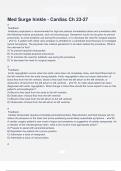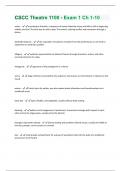STUVIA 2024/2025
Med Surge hinkle - Cardiac Ch 23-27
A
Feedback:
Antibiotic prophylaxis is recommended for high-risk patients immediately before and sometimes after
the following invasive procedures, such as bronchoscopy. Gentamicin would not be given to prevent
pneumonia, to avoid antibiotic use during the procedure, or to decrease the need for surgical asepsis.
- ✔✔12. A patient with mitral valve prolapse is admitted for a scheduled bronchoscopy to investigate
recent hemoptysis. The physician has ordered gentamicin to be taken before the procedure. What is
the rationale for this?
A) To prevent bacterial endocarditis
B) To prevent hospital-acquired pneumonia
C) To minimize the need for antibiotic use during the procedure
D) To decrease the need for surgical asepsis
A
Feedback:
Aortic regurgitation occurs when the aortic valve does not completely close, and blood flows back to
the left ventricle from the aorta during diastole. Aortic regurgitation does not cause obstruction of
blood flow from the left ventricle, blood to flow back from the left atrium to the left ventricle, or
%
obstruction of blood from the left atrium to left ventricle. - ✔✔19. An older adult patient has been
diagnosed with aortic regurgitation. What change in blood flow should the nurse expect to see on this
patient's echocardiogram?
A) Blood to flow back from the aorta to the left ventricle
B) Obstruction of blood flow from the left ventricle
C) Blood to flow back from the left atrium to the left ventricle
D) Obstruction of blood from the left atrium to left ventricle
A
Feedback:
Cardiac tamponade requires immediate pericardiocentesis. Beta-blockers and fluid boluses will not
relieve the pressure on the heart and prone positioning would likely exacerbate symptoms. - ✔✔39.
A cardiac surgery patient's new onset of signs and symptoms is suggestive of cardiac tamponade. As
a member of the interdisciplinary team, what is the nurse's most appropriate action?
A) Prepare to assist with pericardiocentesis.
B) Reposition the patient into a prone position.
C) Administer a dose of metoprolol.
D) Administer a bolus of normal saline.
A
stuvia
, STUVIA 2024/2025
Feedback:
DCM is distinguished by significant dilation of the ventricles without simultaneous hypertrophy. The
ventricles have elevated systolic and diastolic volumes, but a decreased ejection fraction.
Bradycardia and mitral valve regurgitation do not typically occur in patients with DCM. - ✔✔29. The
cardiac nurse is caring for a patient who has been diagnosed with dilated cardiomyopathy (DCM).
Echocardiography is likely to reveal what pathophysiological finding?
A) Decreased ejection fraction
B) Decreased heart rate
C) Ventricular hypertrophy
D) Mitral valve regurgitation
A
Feedback:
Group A streptococcus can cause rheumatic heart fever, resulting in rheumatic endocarditis. Being
aware of signs and symptoms of streptococcal infections, identifying them quickly, and treating them
promptly, are the best preventative techniques for rheumatic endocarditis. Smoking cessation,
immunizations, and calcium channel blockers will not prevent rheumatic heart disease. - ✔✔11. A
community health nurse is presenting an educational event and is addressing several health
problems, including rheumatic heart disease. What should the nurse describe as the most effective
way to prevent rheumatic heart disease?
%
A) Recognizing and promptly treating streptococcal infections
B) Prophylactic use of calcium channel blockers in high-risk populations
C) Adhering closely to the recommended child immunization schedule
D) Smoking cessation
A
Feedback:
Hospital-acquired infective endocarditis occurs most often in patients with debilitating disease or
indwelling catheters and in patients who are receiving hemodialysis or prolonged IV fluid or antibiotic
therapy. Patients taking immunosuppressive medications or corticosteroids are more susceptible to
fungal endocarditis. Patients on immunoglobulins, those who need in and out catheterization, and
children are not at increased risk for nosocomial infective endocarditis. - ✔✔36. The nurse on the
hospital's infection control committee is looking into two cases of hospital-acquired infective
endocarditis among a specific classification of patients. What classification of patients would be at
greatest risk for hospital-acquired endocarditis?
A) Hemodialysis patients
B) Patients on immunoglobulins
C) Patients who undergo intermittent urinary catheterization
D) Children under the age of 12
stuvia
, STUVIA 2024/2025
A
Feedback:
Orthotopic transplantation is the most common surgical procedure for cardiac transplantation. The
recipient's heart is removed, and the donor heart is implanted at the vena cava and pulmonary veins.
Some surgeons still prefer to remove the recipient's heart, leaving a portion of the recipient's atria
(with the vena cava and pulmonary veins) in place. Homografts, or allografts (i.e., human valves), are
obtained from cadaver tissue donations and are used for aortic and pulmonic valve replacement.
Xenografts and heterotropic transplantation are not terms used to describe heart transplantation. -
✔✔14. The nurse is preparing a patient for cardiac surgery. During the procedure, the patient's heart
will be removed and a donor heart implanted at the vena cava and pulmonary veins. What procedure
will this patient undergo?
A) Orthotopic transplant
B) Xenograft
C) Heterotropic transplant
D) Homograft
A
Feedback:
Patients who take warfarin (Coumadin) after valve replacement have individualized target INRs;
usually between 2 and 3.5 for mitral valve replacement and 1.8 and 2.2 for aortic valve replacement.
%
Natural sources of vitamin K do not normally need to be avoided and ASA is not indicated. Sleeping
upright is unnecessary. - ✔✔20. A patient who has undergone valve replacement surgery is being
prepared for discharge home. Because the patient will be discharged with a prescription for warfarin
(Coumadin), the nurse should educate the patient about which of the following?
A) The need for regularly scheduled testing of the patient's International Normalized Ratio (INR)
B) The need to learn to sleep in a semi-Fowler's position for the first 6 to 8 weeks to prevent emboli
C) The need to avoid foods that contain vitamin K
D) The need to take enteric-coated ASA on a daily basis
A
Feedback:
Sodium is the major electrolyte involved with cardiomyopathy. Cardiomyopathy often leads to heart
failure which develops, in part, from fluid overload. Fluid overload is often associated with elevated
sodium levels. Consequently, sodium levels are followed more closely than other important laboratory
values, including BUN, leukocytes, and liver function tests. - ✔✔23. A patient is admitted to the
critical care unit (CCU) with a diagnosis of cardiomyopathy. When reviewing the patient's most recent
laboratory results, the nurse should prioritize assessment of which of the following?
A) Sodium
B) AST, ALT, and bilirubin
C) White blood cell differential
stuvia
, STUVIA 2024/2025
D) BUN
A
Feedback:
Some valvuloplasty procedures do not require general anesthesia or cardiopulmonary bypass and
can be performed in a cardiac catheterization laboratory or hybrid room. Open heart surgery is not
required and the procedure does not carry exceptional risks that would designate it as being
dangerous. Normally there is no need for the nurse to advocate for a second opinion. - ✔✔26. A
patient has been diagnosed with a valvular disorder. The patient tells the nurse that he has read
about numerous treatment options, including valvuloplasty. What should the nurse teach the patient
about valvuloplasty?
A) "For some patients, valvuloplasty can be done in a cardiac catheterization laboratory."
B) "Valvuloplasty is a dangerous procedure, but it has excellent potential if it goes well."
C) "Valvuloplasty is open heart surgery, but this is very safe these days and normally requires only an
overnight hospital stay."
D) "It's prudent to get a second opinion before deciding to have valvuloplasty."
A
Feedback:
When heart failure progresses and medical treatment is no longer effective, surgical intervention,
%
including heart transplantation, is considered. Valvuloplasty, stent placement, and cardiac
catheterization will not address the pathophysiology of cardiomyopathy. - ✔✔32. A patient has been
living with dilated cardiomyopathy for several years but has experienced worsening symptoms
despite aggressive medical management. The nurse should anticipate what potential treatment?
A) Heart transplantation
B) Balloon valvuloplasty
C) Cardiac catheterization
D) Stent placement
A, B, C
Feedback:
Possible complications include aortic regurgitation, emboli, ventricular perforation, rupture of the
aortic valve annulus, ventricular dysrhythmia, mitral valve damage, and bleeding from the catheter
insertion sites. Atrial-septal defect and plaque formation are not complications of a balloon
valvuloplasty. - ✔✔27. The patient has just returned to the floor after balloon valvuloplasty of the
aortic valve and the nurse is planning appropriate assessments. The nurse should know that
complications following this procedure include what? Select all that apply.
A) Emboli
B) Mitral valve damage
C) Ventricular dysrhythmia
stuvia





